The Kitchen Table Layout (2007 - 2009)
This was my first Japanese layout, the one before Sumida Crossing. When construction started on that it was retired and the track and structures recycled into the new layout.
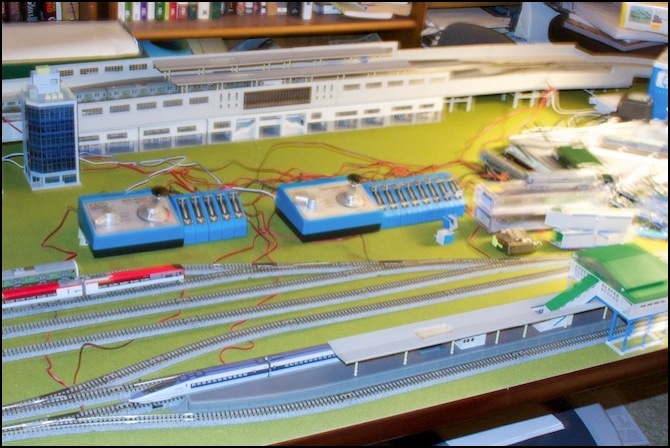
The original KTL, with green Overhead Station (front) and a small passenger train yard
Many Japanese layouts are temporary, due to lack of any space in typical housing for a large, permanent, structure. Sectional track systems like Kato's Unitrack are designed for this environment, where layouts are assembled and dis-assembled on a regular basis. Scenery on these often consists of a few buildings on the bare wooden floor. That's not a good idea in a house with carpet, as fibers can easily jam the mechanism.
But the idea of a minimalist layout on a table-top appealed to me as a way to get my feet wet, and see if I was going to enjoy Japanese trains, or if it was just a passing interest. Unlike Japanese layouts, it wasn't really temporary as I don't use the dining room table often, so it could be left set up. What I did do was experiment with the track arrangement over time. What you see here is largely the end result of that, as I didn't keep a record of my experiments. In the end it lasted nearly two years before being disassembled so the track and structures could become part of the new permanent layout in the basement.
Apologies for the poor photos: I didn’t yet have my good camera, and I had no thoughts of publishing the photos online at the time, so I didn’t worry about the blurriness due to the poor lighting in the room (mainly from a floor lamp).
On the Table
My first attempt at an N-scale Japanese-themed layout was simply a double-track loop of Unitrack on the dining table (it’s a big table), with two passenger stations and a yard. A branch line and small freight yard were added later, after I acquired a couple of freight locomotives. It served me, in various arrangements, for over a year, and provided ideas for the later design.
At this point, I just wanted to run trains and get a feel for the visual impact of the trains and stations, and didn’t worry about adding detail, or even removable parts, to the buildings. The track was also missing overhead wire poles and was simply laid atop a Woodland Scenics grass mat on the tabletop, with a few buildings and cars planted to provide a sense of scale.
The track was all Kato Unitrack, starting with a V11 banked half-loop and adding some banked track and some old non-banked viaduct sections (the banked track snapped in fairly easily). There was a separate power pack for each track, and power was fed from just one place on each loop. When the freight yard and branch were added, a third power pack for the yard and branch were also added, with a single feeder in the yard. Power-routing turnouts fed power to the passenger yard from the inner loop, or not, depending on how each turnout was set. This allowed me to run three separate trains (inner loop, outer loop, and freight branch) while parking additional ones in the yard or passing sidings.
All turnouts were electrified #6, and the two loops connect with a crossover in the front station (if you set both throttles to the same direction and speed, a train will cross over smoothly).
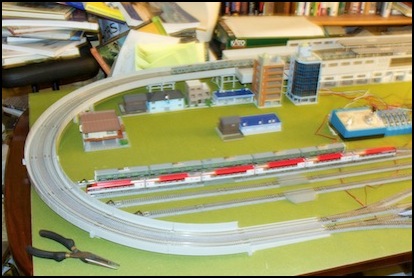
Passenger yard, with Yamanote E231 (silver) and Narita Express (red/white)
The front station was originally a Kato Overhead Station (seen at top), and there was a simple yard for a few passenger trains. It later was replaced (see below) with a City Station (the original name for what is now known as the Overhead Transit Station), although I didn’t have the new platforms that go with that. The rear station was a Viaduct Station with some expansion sets to allow for four tracks. Both stations had passing tracks and island platforms, and were limited to 6-car trains, which wasn’t long enough to make me happy. Memo to self: longer station tracks are a necessity.
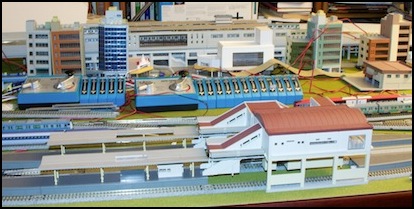
Overhead station (missing a platform) and power packs with turnout controls
Eventually, a freight yard (connected to the passenger yard) was added, with a small branch line looping around the inside of the main loop to a terminal on the left end. This allowed freights to be assembled (using the red DE10 diesel locomotive on the front track of the yard), and sent out to the main behind the EF210 on the second yard track. A couple of passenger trains ended up being stored in the yard due to lack of space. Memo to self: you can never have enough storage tracks.
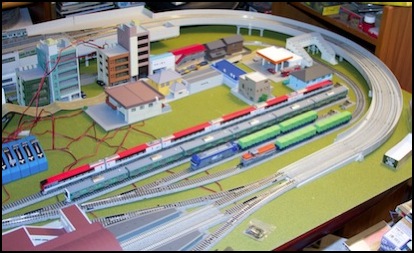
Freight yard with Narita Express (red/white), Yamanote E231 (silver) and container train (green containers)
Here’s a view of the rear station, showing how the station tracks split. The freight yard was still under assembly at this point (I never really finished it), and you can see the branch line running between the station and the buildings.
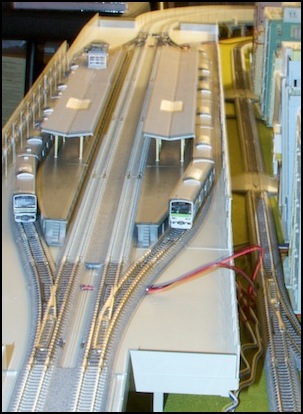
Viaduct station with two parked commuter trains, and freight branch
This layout was a lot of fun. I didn't need to unpack trains, as I had few enough that they would all fit on the station or yard tracks. And I could just walk in after work, run a few trains and relax. But I kept buying trains, which meant I wanted more storage, and there wasn't any room for expansion. I also wanted to run more than two trains at a time to make up for the simplicity of running passenger trains from one station to the next (the freight yard was an attempt at that, which partially worked). And I wanted longer trains and more scenery, and all of that led to the eventual development of Sumida Crossing.
The KTL has since been disassembled, to provide track for construction of Sumida Crossing.




